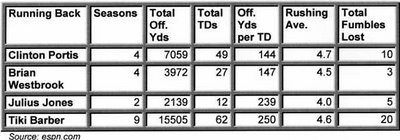The standard measure of running back efficiency is "rushing yards per attempt," with the benchmark being four yards per attempt. The back who exceeds four yards per attempt is an effective rusher. A journeyman achieves around 3.5 yards. Get less than that and a back better be good on special teams. Bill Walsh changed the rules with the west coast offense, where wide receivers caught for short yards in situations that once were the province of rushers. Concurrently, running backs emerged as primary receiving targets in hopes they would use their skills to gain yards after the catch.
The west coast changed the way backs are valued. While there will always be a place for a Jerome Bettis type ground pounder, twenty-first century backs are measured by total offensive yards. The table below compares career total offensive yards (total offense = rushing + passing yards) to total touchdowns. By this measure, Clinton Portis is a beast, taking the fewest yards to score of any back in the NFC East. Brian Westbrook is a close second. Half of his touchdowns have come through the air. Andy Reid is a Bill Walsh disciple, so Westbrook's numbers are no surprise. Portis does not play in west coast offense. His performance is an eye-opener.
Of course, no one is going to call Tiki Barber ineffective, despite needing more yards to score than his peers. Like Walter Peyton, his performance is due to longevity and steady improvement. The nine year vet has increased his rushing average in each of the past three years (4.4 rushing yards per attempt in 2003; 5.2 yards per attempt in 2005.) and he scores a lot.
The table below ranks NFC East running backs by offensive yards per score. The lower the yards to score, the more effective the back.
Related article: See The Redskins Report running back ranking here.
Tags:
NFC
Clinton Portis
Brian Westbrook
Tiki Barber
Julius Jones
Cowboys
Eagles
Giants
Redskins
Monday, August 07, 2006
NFC East By The Numbers: Running Backs
Posted by
Master4Caster
at
9:31 PM
![]()
Subscribe to:
Post Comments (Atom)

No comments:
Post a Comment